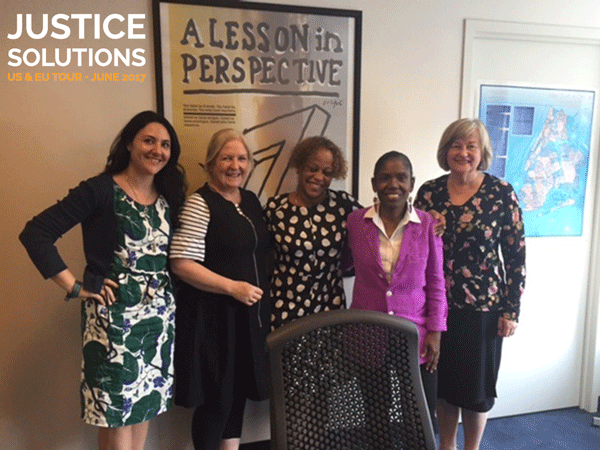As part of our ongoing blog series highlighting the learnings of our Justice Solutions tour, Jesuit Social Services’ Chairman PATRICIA FAULKNER reflects on the many ways New York City is on the pathway to reform.

Jesuit Social Services’ Cath Neville (second from left) and Patricia Faulkner (right) with staff from the NYC Department of Probation.
Today is the last day in New York City on our Justice Solutions tour. Over the last few days we have met with staff from policy think tanks, who gather data and evidence and campaign for reforms in justice systems. We have also met with staff from government agencies and not-for-profit organisations who are implementing a raft of reforms to the way in which juvenile justice is delivered.
New York City is on the pathway to reform. This is well overdue, given the long history of unnecessary incarceration of the poor and excluded, particularly people of colour.
This reform is being driven by a broad coalition of practitioners, researchers, advocates, clinicians interested in children’s brain development, not-for-profits and philanthropically funded research institutes that compile persuasive data on the impact of varying approaches to juvenile justice.
What was a little surprising to me is that this reform has also been supported by fiscal conservatives as well as right wing faith communities who see the sense and fairness in pursuing such an agenda.
How New York City is reforming its justice system
Reform in New York is happening on many fronts:
- A campaign to Raise the Age at which young offenders face adult courts and are incarcerated in adult prisons. This recently resulted in legislation to enable 16 and 17 year olds to be treated in the Juvenile system.
- There is a huge investment to divert young people from further penetration into the system, through provision of wrap around services through probation staff.
- We observed provision for intensive multidisciplinary assessment and the preparation of individualised plans for young offenders. The average stay of a young offender in an assessment facility is 28 days. In that time they will be assessed by educationalists, doctors, dentists, psychiatrists and alcohol and drug specialists. The plan that is developed aims ensure that the child can re-enter family and community at the end of the sentence, in good health.
- Well-articulated practice models have been developed and staff are trained to use these models. The goal of these models is to re-socialise the young offender, not to punish them. Some facilities engage practice auditors or coaches to ensure that the model is rolled out correctly.
- There is wide support for detaining young offenders ‘close to home’ to maximise their ability to reintegrate with family, school and community.
- Intensive support is available to enable young offenders to catch up and advance their educational achievement. Graduation ceremonies are commonplace within facilities.
- Health professionals, including dentists, doctors, psychiatrists, and alcohol and drug specialists are regularly on site and commonly on the staff of the facility.
- Practical support (such as housing and job search assistance) is offered to families to maximise the prospects of successfully reuniting with the young offender.
We still see attention to security, yet there is an increasing acceptance that there needs to be a focus on (re)socialisation, and based on evidence that the brain of a young offender is still developing and changed behaviour is possible.
How New York City’s justice system compares to ours
So, what do I see as the differences between Victoria, Australia, and New York City?
First, New York City politicians are driven by a political imperative to redress the harm that is done through the incarceration of young people, particularly the harm to the people of colour.
Incarceration does damage to a young offender through the mere separation from family and community. Victorian politicians weigh this as less important than a perception of fear in the community about young people’s behaviour.
Second, Victorian politicians are less attentive to evidence and costs. They are prepared to adopt higher costs and less effective solutions to deal with overstated fears in the community which are amplified, not analysed, by journalists.


